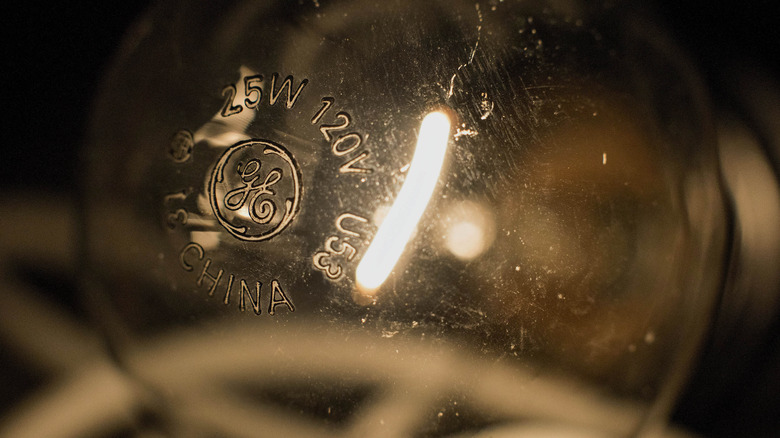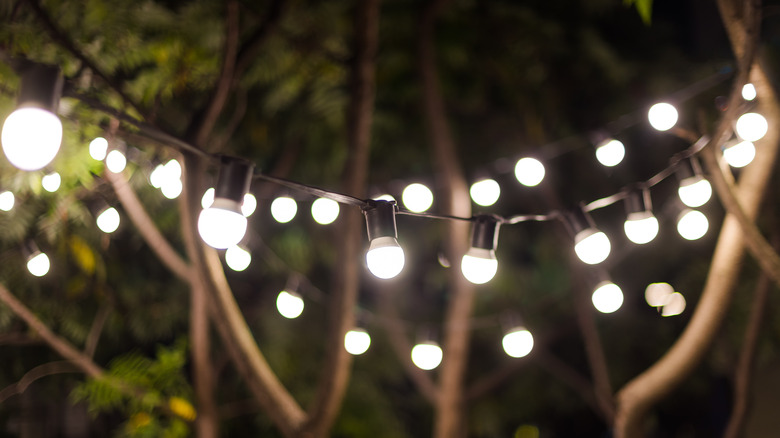The 120-Year Mystery Of The Longest Burning Lightbulb
It's safe, and sad, to say that most of us are probably used to light bulbs blowing out fairly frequently. Folks might keep a stash of spare, equally cheap bulbs in a closet, under a sink, tucked in a box in the garage — that kind of thing — to ensure they don't have to freak over the loss of optimal light for more than a few meager minutes. This is how dependent we've grown on a technology not even 200 years old. In 1835, those first luminary (literally) inventors might not have been able to foresee the dramatic way that perpetual, minimal-fuss, non-sun-regulated light would dramatically overhaul nearly every aspect of human life, down to the basics of sleep cycles, working hours, personal habits, and more.
By 1879, as Easily Green describes, Thomas Edison's team had managed to develop a bulb with a filament that could burn for 14.5 hours straight. How? He baked a cotton thread until it completely transformed into carbon, i.e., a "carbonized cotton thread," as Signify explains. Edison's team tried over 1,200 different materials before hitting on cotton. From there, they moved to bamboo, which improved the life of the bulb to a much-larger 1,200 hours. It was this standard bulb that Edison marketed for the following 10 years.
The most long-lasting, modern LED lights last up to about 50,000 hours (not quite six years, per Bulbs). But would you believe that there exists a bulb that's been burning since it was switched on in 1901?
A world-record-holding, award-winning bulb
In 2015, the "Centennial Light Bulb," as the now-121-year-old light has been dubbed, reached an impossible 1 million hours of burning. As Oldest continues, the bulb was moved to Fire Station 6 in Livermore, California in 1976, where it's taken up permanent residence to the present. The seemingly immortal bulb received its own Centennial Bulb website and "bulbcam," where curious viewers can glimpse the bulb gleaming in all of its incandescent, 4-watt glory.
The bulb's website is a treasure trove of facts and data related to the bulb's history, development, anniversaries, series of "custodians," tests conducted to verify its authenticity, and much, much more. The website also notes the Centennial Light Bulb's status as world record holder for "longest burning light bulb" (also recorded on the Guinness World Records site), and its awards page contains letters of congratulations from former president George W. Bush, the State Senate of California, and many more. At present, the bulb is left on 24-7 as a nightlight for the firehouse, as the facts page states.
Over its entire lifetime, the bulb has never strayed far from home. It was first installed in a "fire hose cart house" on L street in Livermore in 1901, and moved around a bit after that. During its first 75 years it was connected directly to city power, but left unconnected to any backup generators for fear of blowing from power surges. By all accounts, the longest it's been off is 9.5 hours in 2013.
A unique engineering mystery
Upon leaning about the Centennial Light Bulb, folks will likely blurt, "How is that possible?" perhaps followed up by, "Why are my new, fancy-pants bulbs such crap?" To the latter we say, "Got to keep that minimal viable product train rolling." To the former we say, "It's complicated."
As Centennial Bulb website states, the Centennial Light Bulb wound up in the hands of the Livermore Fire Department in 1901 on donation from Dennis Bernal, owner of the Livermore Power and Light Co. The bulb itself was manufactured by the Shelby Electric Company in Shelby, Ohio. As the Shelby Museum of History says, the Shelby Electric Company was formed in 1897 when French immigrant Adolphe Chaillet teamed up with John C. Fish (a 1897 flyer for the company is available on the bulb's Shelby page). Chaillet, it seems, had developed a superior model of bulb that used a particular "coiled filament carbon lamp."
The Centennial Light Bulb is an incandescent bulb, the oldest type of light bulb. Incandescent bulbs generate light using nothing more complex than running electricity through some material (a filament) until it gets so hot that it glows. The filament of the Centennial Light Bulb, however, as Live Science says, is about eight times thicker than bulbs of the time. More pointedly, the filament — presumably devised by Chaillet — is a semiconductor, a hybrid conductor-insulator substance used extensively in modern computers (via Hitachi Hightech). The hotter is gets, the better it conducts electricity.
A low-watt, hibernating bulb
The Centennial Light Bulb's thick filament and semiconductor properties aren't enough to explain why it hasn't died by now, though, especially given the wear and tear to which a bulb is typically subjected. Bulbs blow due to loose connections that cause electric arcs to "jump" and produce irregular heat surges (via DIY Doctor), or bulbs screwed too tightly, nearby vibrations in walls or ceilings, irregularities in voltage, or switching a light on and off too quickly (via BLT Direct). It's inconceivable to think that a 120-year-old bulb hasn't been subjected to such conditions over the course of its life.
As Live Science reported in 2011, Debora Katz, physicist at the U.S. Naval Academy in Annapolis, Maryland, stated that the Centennial Light Bulb might just be a one-in-a-kind fluke. At the time, she ran tests on other, similar Shelby bulbs to investigate the Centennial Light Bulb's properties. These "Annapolis Tests," discussed in full on the Centennial Bulb website, uncovered some details about the Centennial Light Bulb, but nothing to account for its unnatural longevity.
Katz suggested that the bulb's wattage might provide us with a clue. Modern bulbs often run at a high wattage to produce bright lights. The Centennial Light Bulb was originally a mere 30-watt bulb, but over time has dimmed to its current, consistent, 4 watts. Katz likened the bulb to a low-metabolism animal conserving energy over time, like bears hibernating during winter.
Mythbusters paid a visit in 2006
Over the course of its longer-than-a-human-life life, the Centennial Light Bulb has drawn quite a bit of attention. "MythBusters" visited Fire Station 6 in 2006 and spoke with Chief Jeff Zolfarelli about the bulb, as the Centennial Bulb website shows (clip available on YouTube). Zolfarelli echoed physicist Deborah Katz's conclusions regarding the longevity of the bulb (explained on Live Science), stating that its carbon filament burns at a lower temperature than other, modern, thinner filaments made of materials such as titanium. MythBuster Grant Imahara immediately spotted the thickness of the filament, as well. Incidentally, the Centennial Light Bulb is also made from hand-blown glass. It's unknown whether or not this has had any affect on the bulb's lifespan, but it's nice to think that a personal, hand-crafted touch has helped keep the little light going.
All in all, in looks like Adolphe Chaillet's 1897 design has stood the test of time better than any bulb since, even if the Centennial Light Bulb is indeed one-of-a-kind. Despite being such a ubiquitous piece of technology and fixture of modern life (wordplay intended), bulbs have evolved considerably since the 19th century. We've got energy-draining halogen bulbs, compact and long-lasting fluorescent lamps, energy-efficient LED lights, and more (via Hampshire Light). And yet, the ever-bright Centennial Light Bulb remains, in more ways than one, the most incandescent of them all.




